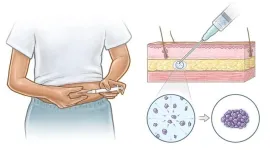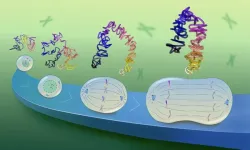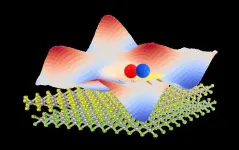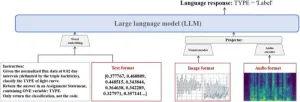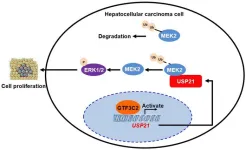(Press-News.org) Mass General Brigham and MIT investigators have developed a long-acting contraceptive implant that can be delivered through tiny needles to minimize patient discomfort and increase the likelihood of medication use.
Their findings in preclinical models provide the technological basis to develop self-administrable contraceptive shots that could mimic the long-term drug release of surgically implanted devices.
The new approach, which would reduce how often patients need to inject themselves and prove valuable for patients with less access to hospitals and other medical care providers, is described in Nature Chemical Engineering.
“Needle size and liquid viscosity are crucial considerations for commercial translation of injectables,” said senior author Giovanni Traverso, MB, PhD, MBBCH, of the Division of Gastroenterology in the Department of Medicine at Brigham and Women’s Hospital, a founding member of the Mass General Brigham healthcare system. “Our engineering challenge was finding a way to maximize comfort for patients by using smaller needles, which cause less bruising or bleeding, and to make the viscosity low enough for easy application with the syringe by hand.”
Traditional contraceptive implants are small, flexible rods that are surgically inserted under the skin to slowly deliver drugs over time, removing the hassle of remembering to take a pill. But the surgery required for implants makes them less accessible to some patients.
Traverso’s team developed a new approach to deliver the contraceptive drug levonorgestrel (LNG) through Self-assembling Long-acting Injectable Microcrystals (SLIM). SLIM act like tiny puzzle pieces that, once injected inside the body, undergo solvent exchange to assemble into a single solid implant that slowly releases the drug as the surface erodes. Unlike similar self-administering technologies, the solvent exchange assembly enables delivery by much smaller needles.
The researchers will continue their work to optimize the dosing, duration, and injectability of the SLIM system, including understanding how it performs in the human body. The design could also be applied to other hydrophobic drugs, which make up most new pharmaceuticals. The researchers plan to investigate how different drug properties impact the SLIM system’s effectiveness.
“We anticipate that SLIM could be a new addition to the current suite of family planning options available to women, especially for people in low-resource settings where options for contraception and health care facilities are limited,” said Traverso.
Authorship: In addition to Traverso, Mass General Brigham and MIT authors include Vivian R. Feig, Sanghyun Park, Pier Giuseppe Rivano, Jinhee Kim, Benjamin Muller, Ashka Patel, Caroline Dial, Sofia Gonzalez, Hannah Carlisle, Flavia Codreanu, Aaron Lopes, Ayten E. Erdogan, Jason Li, and Jia Liang. Other authors include Niora Fabian, Ashley Guevara, Andrew Pettinari, and Mark W. Tibbitt.
Disclosures: The authors report the submission of a provisional patent application (Patent application number: 63/543,528) encompassing the technologies described.
Funding: This work was supported by the Bill & Melinda Gates Foundation (INV-033156, INV064313), the Karl van Tassel (1925) Career Development Professorship, and the Department of Mechanical Engineering, Massachusetts Institute of Technology (MIT).
Paper cited: Feig, V, Park, S, Rivano, P, et al. “Self-assembling Long-acting Injectable Microcrystals (SLIM)” Nature Chemical Engineering DOI: 10.1038/s44286-025-00194-x
END
New non-surgical contraceptive implant is delivered through tiny needles
Preclinical study by Mass General Brigham researchers suggests a more patient-friendly approach to self-administered contraceptive shots that could offer an alternative to surgically implanted devices
2025-03-24
ELSE PRESS RELEASES FROM THIS DATE:
Motion sickness brain circuit may provide new options for treating obesity
2025-03-24
Motion sickness is a very common condition that affects about 1 in 3 people, but the brain circuits involved are largely unknown. In the current study published in Nature Metabolism, researchers at Baylor College of Medicine, the University of Texas Health Science Center at Houston and the Jan and Dan Duncan Neurological Research Institute at Texas Children’s Hospital describe a new brain circuit involved in motion sickness that also contributes to regulating body temperature and metabolic balance. The findings may provide unconventional strategies ...
New research reveals secrets about locust swarm movement
2025-03-24
MEDIA INQUIRES
WRITTEN BY
Laura Muntean
Adam Russell
laura.muntean@ag.tamu.edu
601-248-1891
FOR ...
Age-specific trends in pediatric and adult firearm homicide after the onset of the COVID-19 pandemic
2025-03-24
About The Study: This study found a disproportionate spike in firearm homicide among children and adults older than age 30 after the onset of the COVID-19 pandemic, indicating a change in the association between age and firearm victimization risk. This trend moved the peak victimization risk from age 21 to 19, and rates for children up to age 16 were markedly elevated. These age-specific patterns were most pronounced in later post-onset years.
Corresponding Author: To contact the corresponding author, Jonathan ...
Avoidable mortality across US states and high-income countries
2025-03-24
About The Study: This study found that avoidable mortality (comprising both preventable deaths related to prevention and public health and treatable deaths related to timely and effective health care treatment) has worsened across all U.S. states, while other high-income countries show improvement. The results suggest poorer mortality is driven by broad factors across the entirety of the U.S. While other countries appear to make gains in health with increases in health care spending, such an association does not exist across U.S. states, raising questions regarding U.S. health spending efficiency.
Corresponding Author: To contact the corresponding author, Irene ...
Breastfeeding duration and child development
2025-03-24
About The Study: Exclusive or longer duration of breastfeeding was associated with reduced odds of developmental delays and language or social neurodevelopmental conditions in this cohort study. These findings may guide parents, caregivers, and public health initiatives in promoting early child development.
Corresponding Author: To contact the corresponding author, Inbal Goldshtein, PhD, email inbal@kinstitute.org.il.
To access the embargoed study: Visit our For The Media website at this link https://media.jamanetwork.com/
(doi:10.1001/jamanetworkopen.2025.1540)
Editor’s Note: Please see the ...
How chromosomes shape up for cell division
2025-03-24
Among the many marvels of life is the cell’s ability to divide and thus enable organisms to grow and renew themselves. For this, the cell must duplicate its DNA – its genome – and segregate it equally into two new daughter cells. To prepare the 46 chromosomes of a human cell for transport to the daughter cells during cell division, each chromosome forms a compact X-shaped structure with two rod-like copies. How the cell achieves this feat remains largely unknown.
Now, for the first time, EMBL scientists have directly observed this process in high resolution under the microscope ...
Study identifies gut sensor that propels intestines to move
2025-03-24
After every meal, the intestines perform an action called peristalsis — moving food through their hollow interiors with coordinated contractions and relaxations of the smooth muscle.
For more than a century, scientists have known that nerve cells in the gut propel the colon to move, allowing the organ to perform its life-sustaining function. But exactly how these intestinal nerve cells do their job has remained elusive.
Now a new NIH-funded study led by researchers at Harvard Medical School and the Icahn School of Medicine at Mount Sinai has identified ...
Moiré than meets the eye
2025-03-24
A moiré pattern appears when you stack and rotate two copies of an image with regularly repeating shapes, turning simple patterns of squares or triangles into a groovy wave pattern that moves across the combined image in an optical delight.
Similarly, stacking single layers of sub-nanometer-thick semiconductor materials known as transition metal dichalcogenides (TMDs) can generate a moiré potential, and novel electronic and optoelectronic properties may emerge between the layers.
A moiré potential is a “seascape” of potential energy with regularly repeating peaks and valleys. They were previously thought to be stationary. But a team of ...
AI reshapes how we observe the stars
2025-03-24
AI tools are transforming how we observe the world around us — and even the stars beyond. Recently, an international team proved that deep learning techniques and large language models can help astronomers classify stars with high accuracy and efficiency. Their study, “Deep Learning and Methods Based on Large Language Models Applied to Stellar Light Curve Classification,” was published Feb. 26 in Intelligent Computing, a Science Partner Journal.
The team introduced the StarWhisper LightCurve series, a trio of AI models, and evaluated their performance ...
GTF3C2 promotes the proliferation of hepatocellular carcinoma cells through the USP21/MEK2/ERK1/2 pathway
2025-03-24
Background and Aims
General transcription factor IIIC subunit 2 (GTF3C2) is one of the polymerase III transcription-related factors. Previous studies have revealed that GTF3C2 is involved in regulating cell proliferation. However, the role of GTF3C2 in hepatocellular carcinoma (HCC) remains unclear. This study aimed to determine its expression, biological function, and mechanism in HCC.
Methods
The expression of GTF3C2 in HCC and non-tumor tissues, along with its clinical significance, was investigated using public databases and clinical samples. Reverse transcription-quantitative polymerase ...
LAST 30 PRESS RELEASES:
First Editorial of 2026: Resisting AI slop
Joint ground- and space-based observations reveal Saturn-mass rogue planet
Inheritable genetic variant offers protection against blood cancer risk and progression
Pigs settled Pacific islands alongside early human voyagers
A Coral reef’s daily pulse reshapes microbes in surrounding waters
EAST Tokamak experiments exceed plasma density limit, offering new approach to fusion ignition
Groundbreaking discovery reveals Africa’s oldest cremation pyre and complex ritual practices
First breathing ‘lung-on-chip’ developed using genetically identical cells
How people moved pigs across the Pacific
Interaction of climate change and human activity and its impact on plant diversity in Qinghai-Tibet plateau
From addressing uncertainty to national strategy: an interpretation of Professor Lim Siong Guan’s views
Clinical trials on AI language model use in digestive healthcare
Scientists improve robotic visual–inertial trajectory localization accuracy using cross-modal interaction and selection techniques
Correlation between cancer cachexia and immune-related adverse events in HCC
Human adipose tissue: a new source for functional organoids
Metro lines double as freight highways during off-peak hours, Beijing study shows
Biomedical functions and applications of nanomaterials in tumor diagnosis and treatment: perspectives from ophthalmic oncology
3D imaging unveils how passivation improves perovskite solar cell performance
Enriching framework Al sites in 8-membered rings of Cu-SSZ-39 zeolite to enhance low-temperature ammonia selective catalytic reduction performance
AI-powered RNA drug development: a new frontier in therapeutics
Decoupling the HOR enhancement on PtRu: Dynamically matching interfacial water to reaction coordinates
Sulfur isn’t poisonous when it synergistically acts with phosphine in olefins hydroformylation
URI researchers uncover molecular mechanisms behind speciation in corals
Chitin based carbon aerogel offers a cleaner way to store thermal energy
Tracing hidden sources of nitrate pollution in rapidly changing rural urban landscapes
Viruses on plastic pollution may quietly accelerate the spread of antibiotic resistance
Three UH Rainbow Babies & Children’s faculty elected to prestigious American Pediatric Society
Tunnel resilience models unveiled to aid post-earthquake recovery
Satellite communication systems: the future of 5G/6G connectivity
Space computing power networks: a new frontier for satellite technologies
[Press-News.org] New non-surgical contraceptive implant is delivered through tiny needlesPreclinical study by Mass General Brigham researchers suggests a more patient-friendly approach to self-administered contraceptive shots that could offer an alternative to surgically implanted devices
